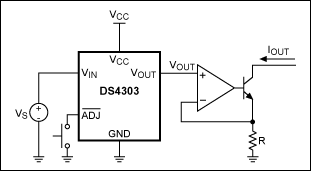要約
This application note describes how to use the DS4303/DS4305 Voltage Sample-and-Infinite-Hold ICs to create a current source (or sink) that is precise and highly flexible, yet inexpensive and simple to implement.
Introduction
Occasionally an application requires an adjustable current source (or sink) to control or bias another system function. Adjustment of such a current is only done once during the application's life, specifically during factory alignment/calibration. The present options for setting a current include hand-picking resistors, adjusting a potentiometer, or utilizing a DAC. All these options are expensive, either in component cost or in calibration cost.
Other applications can require a highly flexible current source, one that must realize both large current ranges (with moderate accuracy) and narrow ranges (with very high accuracy), yet be simple enough to maintain system robustness.
Solving the Problem
To convert the precision voltage output of the DS4303/DS4305 into a current source, a circuit design needs only three additional components: an op amp, a transistor, and a resistor (Figure 1). Using the most inexpensive parts available, the additional circuitry converts the DS4303/DS4305's output voltage into an independent current source by utilizing op amp feedback. As long as the transistor remains biased correctly, the current source will be controllable and accurate (Figure 2). Potential error sources, such as a large op amp offset voltage, low transistor gain, or leakage currents, will all be nulled out during the DS4303/DS4305's adjustment process. Once the adjustment procedure is complete, VIN can be left floating and the resulting current, IOUT, will remain at its desired value.

Figure 1. A simple circuit to realize a precise current source using a DS4303 and several inexpensive components.

Figure 2. A simple circuit to realize a precise current sink using a DS4303 and several inexpensive components.
In the above circuit the resistor, R, must be chosen carefully, not only to set the current range, but also to ensure that the transistor operates within its linear range. Certain current settings above a particular point at the high end of the current range can cause the transistor to saturate, which will result in a reduced maximum current. Conversely, if the op amp uses VCC and GND as its rails, then current settings at the low end of the current range can cause insufficient voltage to overcome the transistor's threshold. In that case, the transistor will turn off. To prevent this, the op amp must provide a slightly negative voltage to continue operation down to the minimum current range. Despite these drawbacks, this circuit will still work perfectly over 80% of the ideal current range.
Accounting for less-than-ideal transistor behavior, R can be calculated to set the desired range and accuracy. After setting R, the DS4303/DS4305's VIN voltage can then be adjusted to set the output current. The following table gives some example parameters that relate R with current span and accuracy.
| DS4303 Minimum VOUT (V) | DS4303 Maximum VOUT (V) | R (Ω) | Maximum IOUT* (mA) | Minimum IOUT (mA) | Current Span (mA) | Current Accuracy ±(mA) |
| 0.3 | 3.3 | 30 | 110 | 10 | 100 | 0.033333 |
| 0.3 | 3.3 | 100 | 33 | 3 | 30 | 0.01 |
| 0.3 | 3.3 | 1000 | 3.3 | 0.3 | 3 | 0.001 |
| 0.3 | 3.3 | 10000 | 0.33 | 0.03 | 0.3 | 0.0001 |
| 0.3 | 3.3 | 100000 | 0.033 | 0.003 | 0.03 | 0.00001 |
| *Using ideal components. | ||||||
Conclusion
This application note describes how to use a DS4303/DS4305 to create an inexpensive flexible current source, capable of sourcing or sinking current. Adjusting the current source's output is as simple as placing a voltage on the DS4303/DS4305's VIN pin and toggling ADJ. This procedure can be repeated until the correct output current value is reached.




















